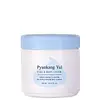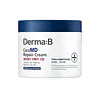What's inside
What's inside
 Key Ingredients
Key Ingredients

 Benefits
Benefits

 Concerns
Concerns

 Ingredients Side-by-side
Ingredients Side-by-side

Water
Skin ConditioningGlycerin
HumectantDipropylene Glycol
HumectantCetearyl Alcohol
EmollientButyrospermum Parkii Butter
Skin ConditioningCaprylic/Capric Triglyceride
MaskingEthylhexyl Palmitate
EmollientHelianthus Annuus Seed Oil
EmollientOctyldodecanol
EmollientPolyglyceryl-3 Distearate
EmulsifyingDimethicone
EmollientGlyceryl Stearate
EmollientButylene Glycol
HumectantEuphorbia Cerifera Cera
AstringentSorbitan Sesquioleate
EmulsifyingCetearyl Glucoside
EmulsifyingCaprylyl Glycol
EmollientGlyceryl Stearate Citrate
EmollientMicrocrystalline Cellulose
AbsorbentPentylene Glycol
Skin ConditioningHydroxyacetophenone
AntioxidantCarbomer
Emulsion StabilisingTromethamine
BufferingCetyl Ethylhexanoate
EmollientCentella Asiatica Extract
CleansingEthylhexylglycerin
Skin ConditioningXanthan Gum
EmulsifyingCellulose Gum
Emulsion StabilisingHydrogenated Lecithin
EmulsifyingDisodium EDTA
Tocopherol
Antioxidant1,2-Hexanediol
Skin ConditioningAllantoin
Skin ConditioningArgania Spinosa Kernel Oil
EmollientSimmondsia Chinensis Seed Oil
EmollientPrunus Amygdalus Dulcis Oil
Skin ConditioningPersea Gratissima Oil
Skin ConditioningPanthenol
Skin ConditioningGlucose
HumectantMacadamia Ternifolia Seed Oil
EmollientAnastatica Hierochuntica Extract
AstringentCholesterol
EmollientBrassica Campestris Sterols
EmollientPhytosteryl/Behenyl/Octyldodecyl Lauroyl Glutamate
Skin ConditioningSodium Hyaluronate
HumectantLonicera Japonica Flower Extract
Skin ConditioningPolyglyceryl-10 Oleate
Skin ConditioningArtemisia Capillaris Extract
Ceramide NP
Skin ConditioningPotassium Cetyl Phosphate
EmulsifyingHydrolyzed Hyaluronic Acid
HumectantHydroxypropyltrimonium Hyaluronate
Sodium Hyaluronate Crosspolymer
HumectantSodium Acetylated Hyaluronate
HumectantCeramide Ns
Skin ConditioningCeramide EOP
Skin ConditioningCitrus Aurantium Bergamia Fruit Oil
MaskingCitrus Aurantium Dulcis Peel Oil
MaskingCitrus Nobilis Peel Oil
MaskingCitral
PerfumingLimonene
PerfumingLinalool
PerfumingWater, Glycerin, Dipropylene Glycol, Cetearyl Alcohol, Butyrospermum Parkii Butter, Caprylic/Capric Triglyceride, Ethylhexyl Palmitate, Helianthus Annuus Seed Oil, Octyldodecanol, Polyglyceryl-3 Distearate, Dimethicone, Glyceryl Stearate, Butylene Glycol, Euphorbia Cerifera Cera, Sorbitan Sesquioleate, Cetearyl Glucoside, Caprylyl Glycol, Glyceryl Stearate Citrate, Microcrystalline Cellulose, Pentylene Glycol, Hydroxyacetophenone, Carbomer, Tromethamine, Cetyl Ethylhexanoate, Centella Asiatica Extract, Ethylhexylglycerin, Xanthan Gum, Cellulose Gum, Hydrogenated Lecithin, Disodium EDTA, Tocopherol, 1,2-Hexanediol, Allantoin, Argania Spinosa Kernel Oil, Simmondsia Chinensis Seed Oil, Prunus Amygdalus Dulcis Oil, Persea Gratissima Oil, Panthenol, Glucose, Macadamia Ternifolia Seed Oil, Anastatica Hierochuntica Extract, Cholesterol, Brassica Campestris Sterols, Phytosteryl/Behenyl/Octyldodecyl Lauroyl Glutamate, Sodium Hyaluronate, Lonicera Japonica Flower Extract, Polyglyceryl-10 Oleate, Artemisia Capillaris Extract, Ceramide NP, Potassium Cetyl Phosphate, Hydrolyzed Hyaluronic Acid, Hydroxypropyltrimonium Hyaluronate, Sodium Hyaluronate Crosspolymer, Sodium Acetylated Hyaluronate, Ceramide Ns, Ceramide EOP, Citrus Aurantium Bergamia Fruit Oil, Citrus Aurantium Dulcis Peel Oil, Citrus Nobilis Peel Oil, Citral, Limonene, Linalool
Water
Skin ConditioningCetearyl Alcohol
EmollientGlycerin
HumectantCetyl Ethylhexanoate
EmollientButylene Glycol
HumectantButyrospermum Parkii Butter
Skin ConditioningStearic Acid
CleansingDimethicone
EmollientPolyglyceryl-3 Methylglucose Distearate
EmulsifyingGlyceryl Stearate
EmollientCeramide NP
Skin ConditioningPanthenol
Skin ConditioningGlycolipids
Skin ConditioningMyristoyl/Palmitoyl Oxostearamide/Arachamide Mea
Skin ConditioningMethylbenzyl Methylbenzimidazole Piperidinylmethanone
Jasminum Officinale Flower Water
MaskingCymbopogon Nardus Oil
MaskingRosa Damascena Flower Water
MaskingPimpinella Anisum Fruit Extract
MaskingVanilla Planifolia Fruit Extract
Skin ConditioningPrunus Persica Extract
CleansingVitis Vinifera Seed Oil
EmollientOlea Europaea Fruit Oil
MaskingHydrogenated Lecithin
EmulsifyingCandida Bombicola/Glucose/Methyl Rapeseedate Ferment
AntimicrobialHydrogenated Polyisobutene
EmollientCetearyl Olivate
Sorbitan Olivate
EmulsifyingPhytosterols
Skin ConditioningSodium Polyacrylate
AbsorbentXanthan Gum
EmulsifyingSodium Phytate
1,2-Hexanediol
Skin ConditioningCaprylyl Glycol
EmollientPhenethyl Alcohol
MaskingWater, Cetearyl Alcohol, Glycerin, Cetyl Ethylhexanoate, Butylene Glycol, Butyrospermum Parkii Butter, Stearic Acid, Dimethicone, Polyglyceryl-3 Methylglucose Distearate, Glyceryl Stearate, Ceramide NP, Panthenol, Glycolipids, Myristoyl/Palmitoyl Oxostearamide/Arachamide Mea, Methylbenzyl Methylbenzimidazole Piperidinylmethanone, Jasminum Officinale Flower Water, Cymbopogon Nardus Oil, Rosa Damascena Flower Water, Pimpinella Anisum Fruit Extract, Vanilla Planifolia Fruit Extract, Prunus Persica Extract, Vitis Vinifera Seed Oil, Olea Europaea Fruit Oil, Hydrogenated Lecithin, Candida Bombicola/Glucose/Methyl Rapeseedate Ferment, Hydrogenated Polyisobutene, Cetearyl Olivate, Sorbitan Olivate, Phytosterols, Sodium Polyacrylate, Xanthan Gum, Sodium Phytate, 1,2-Hexanediol, Caprylyl Glycol, Phenethyl Alcohol
 Reviews
Reviews

Ingredients Explained
These ingredients are found in both products.
Ingredients higher up in an ingredient list are typically present in a larger amount.
1,2-Hexanediol is a synthetic liquid and another multi-functional powerhouse.
It is a:
- Humectant, drawing moisture into the skin
- Emollient, helping to soften skin
- Solvent, dispersing and stabilizing formulas
- Preservative booster, enhancing the antimicrobial activity of other preservatives
Butylene Glycol (or BG) is used within cosmetic products for a few different reasons:
Overall, Butylene Glycol is a safe and well-rounded ingredient that works well with other ingredients.
Though this ingredient works well with most skin types, some people with sensitive skin may experience a reaction such as allergic rashes, closed comedones, or itchiness.
Learn more about Butylene GlycolThis ingredient is also known as shea butter. It is an effective skin hydrator and emollient.
Emollients help soothe and soften your skin. It does this by creating a protective film on your skin. This barrier helps trap moisture and keeps your skin hydrated. Emollients may be effective at treating dry or itchy skin.
Shea butter is rich in antioxidants. Antioxidants help fight free-radicals, or molecules that may harm the body. It is also full of fatty acids including stearic acid and linoleic acid. These acids help replenish the skin and keep skin moisturized.
While Shea Butter has an SPF rating of about 3-4, it is not a sunscreen replacement.
Shea butter may not be fungal acne safe. We recommend speaking with a professional if you have any concerns.
Learn more about Butyrospermum Parkii ButterCaprylyl Glycol is a humectant and emollient, meaning it attracts and preserves moisture.
It is a common ingredient in many products, especially those designed to hydrate skin. The primary benefits are retaining moisture, skin softening, and promoting a healthy skin barrier.
Though Caprylyl Glycol is an alcohol derived from fatty acids, it is not the kind that can dry out skin.
This ingredient is also used as a preservative to extend the life of products. It has slight antimicrobial properties.
Learn more about Caprylyl GlycolCeramide NP is a type of ceramide and formally known as ceramide 3.
Ceramides are intercellular lipids naturally found in our skin that bonds dead skin cells together to create a barrier. They are known for their ability to hold water and thus are a great ingredient for dry skin.
Ceramides are an important building block for our skin barrier. A stronger barrier helps the skin look more firm and hydrated. By bolstering the skin ceramides act as a barrier against irritating ingredients. This can help with inflammation as well.
If you would like to eat ceramides, sweet potatoes contain a small amount.
Read more about other common types of ceramides here:
Ceramide AP
Ceramide EOP
Cetearyl alcohol is a mixture of two fatty alcohols: cetyl alcohol and stearyl alcohol. It is mainly used as an emulsifier. Emulsifiers help prevent the separation of oils and products. Due to its composition, it can also be used to thicken a product or help create foam.
Cetearyl alcohol is an emollient. Emollients help soothe and hydrate the skin by trapping moisture.
Studies show Cetearyl alcohol is non-toxic and non-irritating. The FDA allows products labeled "alcohol-free" to have fatty alcohols.
This ingredient is usually derived from plant oils such as palm, vegetable, or coconut oils. There is debate on whether this ingredient will cause acne.
Due to the fatty acid base, this ingredient may not be Malassezia folliculitis safe.
Learn more about Cetearyl AlcoholCetyl Ethylhexanoate is an emollient ester. It comes from cetearyl alcohol and 2-ethylhexanoic acid.
Cetyl Ethylhexanoate is an emollient that adds a velvety feel to skin without being greasy or oily. Emollients help trap moisture into your skin, keeping your skin soft and hydrated.
Dimethicone is a type of synthetic silicone created from natural materials such as quartz.
What it does:
Dimethicone comes in different viscosities:
Depending on the viscosity, dimethicone has different properties.
Ingredients lists don't always show which type is used, so we recommend reaching out to the brand if you have questions about the viscosity.
This ingredient is unlikely to cause irritation because it does not get absorbed into skin. However, people with silicone allergies should be careful about using this ingredient.
Note: Dimethicone may contribute to pilling. This is because it is not oil or water soluble, so pilling may occur when layered with products. When mixed with heavy oils in a formula, the outcome is also quite greasy.
Learn more about DimethiconeGlycerin is already naturally found in your skin. It helps moisturize and protect your skin.
A study from 2016 found glycerin to be more effective as a humectant than AHAs and hyaluronic acid.
As a humectant, it helps the skin stay hydrated by pulling moisture to your skin. The low molecular weight of glycerin allows it to pull moisture into the deeper layers of your skin.
Hydrated skin improves your skin barrier; Your skin barrier helps protect against irritants and bacteria.
Glycerin has also been found to have antimicrobial and antiviral properties. Due to these properties, glycerin is often used in wound and burn treatments.
In cosmetics, glycerin is usually derived from plants such as soybean or palm. However, it can also be sourced from animals, such as tallow or animal fat.
This ingredient is organic, colorless, odorless, and non-toxic.
Glycerin is the name for this ingredient in American English. British English uses Glycerol/Glycerine.
Learn more about GlycerinGlyceryl Stearate is a mix of glycerin and stearic acid.
It is used to stabilize the mixing of water and oil ingredients. By preventing these ingredients from separating, it can help elongate shelf life. It can also help thicken the product's texture.
As an emollient, it helps soften skin and supports barrier-replenishing ingredients.
In cosmetics, Glyceryl Stearate is often made from vegetable oils or synthetically produced.
This ingredient may not be fungal-acne safe
Fun fact: The human body also creates Glyceryl Stearate naturally.
Learn more about Glyceryl StearateHydrogenated Lecithin is created from the hydrogenation of lecithin (a group of phospholipids). Hydrogenation is a chemical reaction between hydrogen and another element.
This ingredient is an emollient and emulsifier. As an emollient, it helps soften skin by trapping moisture within. As an emulsifier, it prevents oil and water ingredients from separating.
Panthenol is a common ingredient that helps hydrate and soothe the skin. It is found naturally in our skin and hair.
There are two forms of panthenol: D and L.
D-panthenol is also known as dexpanthenol. Most cosmetics use dexpanthenol or a mixture of D and L-panthenol.
Panthenol is famous due to its ability to go deeper into the skin's layers. Using this ingredient has numerous pros (and no cons):
Like hyaluronic acid, panthenol is a humectant. Humectants are able to bind and hold large amounts of water to keep skin hydrated.
This ingredient works well for wound healing. It works by increasing tissue in the wound and helps close open wounds.
Once oxidized, panthenol converts to pantothenic acid. Panthothenic acid is found in all living cells.
This ingredient is also referred to as pro-vitamin B5.
Learn more about PanthenolWater. It's the most common cosmetic ingredient of all. You'll usually see it at the top of ingredient lists, meaning that it makes up the largest part of the product.
So why is it so popular? Water most often acts as a solvent - this means that it helps dissolve other ingredients into the formulation.
You'll also recognize water as that liquid we all need to stay alive. If you see this, drink a glass of water. Stay hydrated!
Learn more about WaterXanthan gum is used as a stabilizer and thickener within cosmetic products. It helps give products a sticky, thick feeling - preventing them from being too runny.
On the technical side of things, xanthan gum is a polysaccharide - a combination consisting of multiple sugar molecules bonded together.
Xanthan gum is a pretty common and great ingredient. It is a natural, non-toxic, non-irritating ingredient that is also commonly used in food products.
Learn more about Xanthan Gum